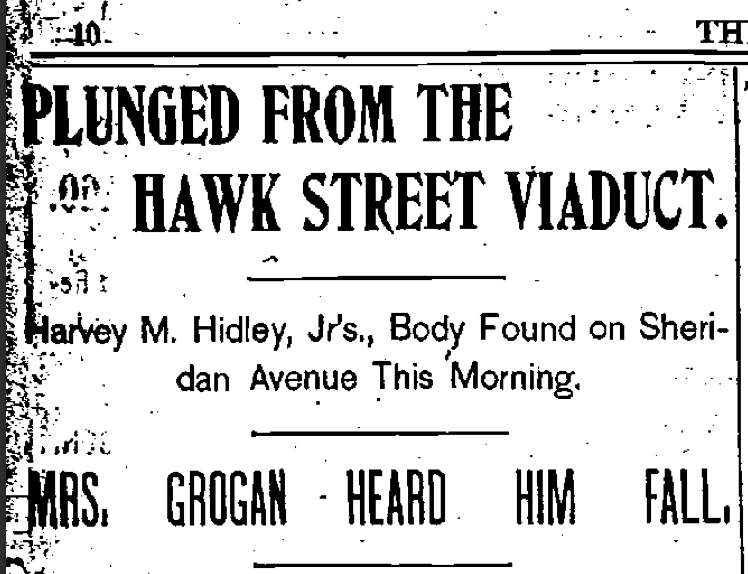
Seems like wherever there’s a tall structure, people will end up flinging themselves off of it. The Hawk Street Viaduct was no exception. From the Albany Evening Journal, March 6, 1900:
“The body of Harvey M. Hidley, jr., was found on Sheridan avenue under the Hawk street viaduct this morning.
“Mrs. John Grogan, who lives near there, heard a crash about 2:30 and sat on her front steps watching the body until 5 o’clock. She was not sure it was a body and was not able to go and ascertain.
“Mrs. Grogan, whose home, 60 Hawk street, is less than 75 feet from where Hidley’s body struck, said to a Journal reporter:
“‘I have been sick and was sitting on our front steps about 2:30 o’clock this morning, when I heard a loud report, like an explosion, which was followed by the electric lights going out. It made an awful noise and I could not imagine what it was. I looked toward the corner of Sheridan avenue and Hawk street and in the middle of Sheridan avenue saw what I thought was a man sitting in the middle of the street. I called my husband, but he thought nothing of it then. Half an hour afterwards one of the Westcott Company’s coaches on its way to the stable was driven by and the driver paid no attention, so I thought that what I saw was a shadow. A few minutes before 5 o’clock John Hewitt, another driver for the Westcott Company, came along and saw the object. He turned around, drove back and telephoned for the police. Then he came back and with my husband went for Father Dillon. When they got back the man was dead.’”
We’d venture to guess that he was dead considerably before the arrival of Father Dillon. We’ll never know if a more intrepid spirit in an undoubtedly sleeping Mr. Grogan could have made a difference, nor will we ever know if he was awakened each and every night by Mrs. Grogan thinking she saw something in the street. Either way, Hidley was a goner. The level of detail in describing the suicide is by no means exceptional for the time:
“Mrs. Grogan says she only heard the man groan once. When he was found by Hewitt his legs were straight out from his body and one arms [sic] was under his head. There was a pool of blood under him which came from a deep cut on his head ….
“It is supposed that Hidley, while walking over the viaduct, was seized with a suicidal mania. The point selected is the highest on the viaduct. It is directly over Sheridan avenue, 85 feet from the pavement. At that point there is a semicircular iron rod from which an electric light hangs. It is supposed that Hidley climbed to the rail at this point and after balancing himself by holding onto the upright, leaped off. In his fall he must have struck an electric light wire, for one parted and caused the noise which Mrs. Grogan heard. This wire extended from the light on the northeast corner of Sheridan avenue and Hawk street to the top of the bridge on the east side and then ran back under the bridge to a pole on the northwest corner. In falling Hidley struck this wire and the rebound threw him under the bridge.”
But perhaps it wasn’t suicide after all. There was at least a theory that Mr. Hidley, who worked for the very company that built the viaduct, was just a good samaritan who noticed that the lights were out and was trying to do something about it. Like any of us would do, climbing up a light pole atop a bridge railing in the middle of the night.
“[Mr. Hidley] was 21 years old and was employed by the Hilton Bridge Company. He is survived by a wife, to whom he was married only a few months ago.
“A young man whose name has not yet been learned by the police or coroner was in the neighborhood of the viaduct this morning and said that ht saw a young man climb upon the rail about 2 o’clock this morning, but he paid no further attention to him, thinking he was going to fix the electric light.
“The theory has sprung from this that Hidley did climb onto the rail to jerk the wire, with the intention of lighting the lamp, and fell off, grabbing the wire in his fall and pulling it with him.
“The police report shows that the light on the viaduct and several others in the vicinity were not burning at 2:30 o’clock this morning.”

Leave a Reply